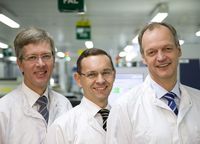German Federal President's Prize For Innovation And Advanced Technology
BERLIN/STUTTGART October 14, 2008: The Office of the German Federal President has announced its shortlist for the 2008 German Future Prize, the award for innovation and advanced technology. From the many first-class entries, the panel of experts has selected four outstanding projects for the final decision which Federal President Horst Köhler will announce on December 3, 2008.
For the fourth time in the ten-year history of this prestigious award, Bosch associates have succeeded in being shortlisted for the final round of four nominated expert teams. The Bosch team, comprising spokesman Dr.-Ing. Jiri Marek and team members Dr.-Ing. Michael Offenberg and Dr.-Ing. Frank Melzer, has developed key processes for surface micro-machining, thus creating the prerequisites for manufacturing small, cost-effective, powerful, and energy-efficient sensors. At the same time, they have taken this technology to a stage where it can be used for large-volume production, opening up a global market for micro-mechanical sensors – a market which Bosch leads today. “Together with all the associates of our company, we are pleased that our team of experts has reached the final round of the 2008 German Future Prize. In itself, being shortlisted by such a high-powered panel of judges is an accolade that makes us all proud,” said Franz Fehrenbach, chairman of the Bosch board of management.
Safety thanks to cost-efficient sensors
If a car detects that
it is skidding and stabilizes itself, if a laptop falls to the floor and
protects the hard drive before impact, if a cell phone calls for help in an
emergency and guides the rescuers reliably to its owner – this is
invariably due to sensors, the “electronic sensory organs”
which perceive the surrounding conditions. Sensors are regarded as the
crucial elements of technical electronic systems that can react ever more
intelligently to human needs – Invented for life.
One important condition for this development is that sensors have become significantly smaller and more powerful, as well as costing less to manufacture and consuming less energy. Marek, Offenberg, and Melzer paved the way for this development. They developed new processes for the manufacture of sensors on silicon wafers in what is known as surface micro-machining. This is regarded as the breakthrough in industrial mass-production for micro-electro-mechanical systems (MEMS).
In principle, micro-machining is an offshoot of modern electronic semiconductor technology. It uses micro-electronic processes to create tiny components that perform mechanical functions. As sensors, for example, they can precisely measure pressure or acceleration. In the print heads of inkjet printers they ensure that paper is printed clearly, and in electronic projectors they control the positioning of the micromirrors. Up to now, mainly “bulk micro-machining” processes have been used in manufacturing. Economically and technically, however, this can only be used for components in larger high-end appliances – in cars, for example, or in industrial plants. For sensor mass applications in consumer electronics , these sensors are too complicated, too big, and their power consumption is too high.
Surface micro-machining as the key to cost-effective sensors
Together with their co-workers, the Bosch team managed to make complex
sensor components using surface micro-machining processes. Unlike the
processes used previously, the structures and components are deposited onto
the surface of a silicon wafer, instead of etching them out of volume
silicon. With their new processes, the Bosch researchers can create
vertical-walled structures in the deposited silicon layers, produce moving
masses and oscillating spring elements, and accurately create vacuum
chambers inside silicon that has been deposited. In addition, they can
combine the sensors with the electronic evaluation function, and protect
their elements against environmental factors with ultra-thin seals that
take up a minimum of space. All of this happens on the micron level, on
structures that are far finer than a human hair, and at a cost that runs
into just a few euros, even for complex sensor systems.
This progress in miniaturization opens up new applications for these sensors in consumer electronics. The Bosch SMB 380 acceleration sensor detects if a laptop has been dropped, and protects the hard disk drive even before it hits the ground. In navigation systems, the micro-mechanical pressure sensor can measure altitude with an accuracy of 25 centimeters, and the precise elevation it provides makes mobile navigation possible even in buildings, as well as automatic emergency call systems. Other applications of these sensors in consumer electronics include weather stations or altimeters in watches, training monitoring sensors in shoes or sportswear, and intuitive user interfaces for cell phones, remote controls, or game consoles that react to faint touches or changes in position.
More than 200 million sensors a year
Bosch currently
manufactures more than 200 million micro-mechanical sensors a year, and is
the world market leader for such sensors. Some 2,000 associates work in
this area at Bosch. As production figures rise, so too does the demand for
electronic circuits for signal processing inside these sensors. It is for
this reason that Bosch is constructing a new semiconductor manufacturing
facility in Reutlingen, Germany. It will produce semiconductors on
eight-inch wafers, and create 800 new jobs. At 600 million euros, it is the
company’s greatest single investment. For micro-mechanical sensors,
consumer electronics is a new market whose great potential has to be
tapped. This was why Bosch Sensortec GmbH was founded in 2005. Worldwide,
more than 50 associates work for this company. The market for
micro-mechanical sensors will continue to grow strongly, especially in the
area of consumer electronics. Worldwide, electronics engineers are working
to make many functions of electronic devices even more user-friendly
– with the help of micro-mechanical sensors.



